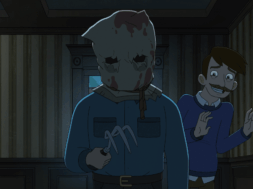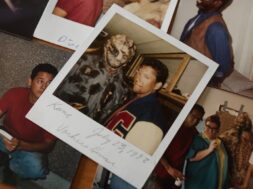What do vampire Barnabas Collins, the Zuni fetish doll, investigative reporter Carl Kolchak, and the haunted Allardyce family home have in common? Producer and director Dan Curtis, the king of television horror. In the era where series and movies could be event television, particularly in the late ‘60s- early ‘70s, Curtis dominated the small screen. Especially in horror. Decades later, the landscape of television has changed dramatically; DVRs, VOD, and various streaming services means made-for-TV movies, miniseries, and the like have fallen largely by the wayside. Or rather, they’re not the momentous occasions they once were. Even still, Curtis remains a pioneer and a major influence in the genre, then and now.
When the Curtis created gothic soap opera Dark Shadows premiered in 1966 on ABC, it faced cancellation almost immediately. Set around in a fictional Maine town of Collinsport, inspired by a dream Curtis had, the series followed the bizarre and often supernatural occurrences that plagued the upper-class Collins family and those near to them. But the supernatural elements were a little slow to appear at first, with plots mostly centered around revenge and murder schemes. Six months in, critics deemed the soap too boring and it failed to gain traction with viewers. ABC warned Curtis that unless he turned the ratings around, Dark Shadows wasn’t going to air much longer. Since Curtis always wanted to do a vampire movie, he decided to write a vampire character for the show. Enter Barnabas Collins. The ratings turned around almost instantly, propelling the soap opera into an enduring cultural phenom that spanned five years, hundreds of episodes, a revival, spinoff films, and more.

Barbanas Collins entered Dark Shadows a typical creature of the night but quickly transformed into tortured antihero. His guilt over past misdeeds gave him a humanity that hadn’t really been portrayed in vampires before, at least not to the extent and depth that over 1,000 episodes allows.
After the series ended in 1971, due to cancellation, Curtis teamed up with horror author and screenwriter Richard Matheson for TV movie The Night Stalker in 1972. Curtis directed, and Matheson adapted the screenplay from a novel by Jeffrey Grant Rice. It introduced Darren McGavin as Carl Kolchak, an intrepid reporter investigating a series of murders in Las Vegas. When he discovers the killer is a vampire, well, he runs into a whole new set of problems. The Night Stalker became the highest rated TV movie of all time (at that time), prompting an immediate follow up with The Night Strangler which saw Kolchak hot on the trails of a 144-year-old alchemist that slayed women for blood. While it didn’t reach the same rating highs of its predecessor, it was still popular enough for ABC to evolve the planned third film into a new series instead. Kolchak: The Night Stalker was a short-lived series, and didn’t involve Curtis or Matheson, but it heavily inspired horror shows like Buffy the Vampire Slayer and The X-Files. None of which might have existed without Curtis and Matheson’s original, mega-popular made-for-TV movie.

Next Curtis terrified TV viewers with The Norliss Tapes, a creepy movie that sees a Sanford Evans trying to piece together the whereabouts of his missing friend, David Norliss, through a series of tapes explaining his recent occult investigation. He reteamed with Matheson a year later to direct Scream of the Wolf before finally getting a chance to direct the vampire film he always wanted in 1974’s Dracula. Starring Jack Palance as Dracula, Curtis’ take on Bram Stoker’s classic tale was the first to connect Dracula to Vlad the Impaler and should’ve been far more popular and successful had it not been for presidential addresses bumping its initial broadcast to a later time. It holds up well, and Francis Ford Coppola’s 1992 adaptation seems to owe a lot to it.
After producing a handful of other television movies centered around iconic literary horror figures, Curtis produced and directed a horror anthology movie based on some of Matheson’s short stories. Starring Karen Black, who played four different characters among the three segments, Trilogy of Terror induced nightmares for generations thanks to final segment “Amelia” and the Zuni fetish doll. The movie didn’t just create one of the most terrifying dolls in history that likely set the bar for killer dolls that came after, it helped establish Black as a horror mainstay, too.
Curtis’ next major contribution to horror set the standard for many of the common tropes found in haunted house movies. It also marked a rare theatrical release, as well as a reteam with Karen Black. Written, produced, and directed by Curtis, based on a 1973 novel of the same name, Burnt Offerings presented a unique type of haunting for the Rolf family when a bargain vacation home turns their summer plans into a nightmare. While the movie has since earned a following, Burnt Offerings didn’t perform well at the box office and marked the last horror theatrical release for Curtis.

In the ‘90s, Curtis attempted to revive Dark Shadows in a more streamlined, prime time series. The initial ratings deemed it a huge success, but NBC kept interrupting or bumping the episodes due to the onset of the Gulf War, causing a massive struggle to retain viewership. So this revival, despite being well received, only lasted twelve episodes. For USA network, Curtis directed sequel Trilogy of Terror II, for which he also wrote the segment “He Who Kills.” This time Lysette Anthony was tasked with playing various characters throughout the three segments, and yes, the Zuni doll does make a reappearance. In 2005, Curtis served as a consulting producer on the short-lived remake Night Stalker, based on Kolchak: The Night Stalker.
Based on the legacy of Dark Shadows alone, Dan Curtis could’ve stopped there and still remained an influential voice in horror. But he didn’t. He dedicated a large portion of his career to the genre, delivering memorable movie after movie and series that refused to leave the pop culture collective no matter how short-lived. His work instilled fear in viewers, but he also dared to give his monsters and characters a complexity they hadn’t really had before. Vampires that became Shakespearean in their tragic histories, fearless yet flawed reporters who sacrifice their own happiness for the sake of truths, and even haunted houses became nuanced characters in Curtis’ hands. His ability to scare was equally matched by his compelling characters that were so relatable. Television programming may be widely different now than it was in the ‘60s and ‘70s, but many horror series released in the decades since were influenced in some way by his pioneering work. He’s more than just the king of television horror; Curtis is a master horror storyteller and a pillar of the genre.









